<< Previous | Displaying results 4901-4950 of 6769 for "" | Next >>
Portrait of Tosia Altman (1918-1943), Jewish youth leader and member of the Jewish underground in the Warsaw ghetto.
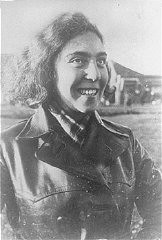
Cover of an underground Yiddish newspaper, Jugend Shtimme (Voice of Youth). Writing on the bottom of the cover reads: "Fascism must be smashed." Warsaw ghetto, Poland, January–February 1941.

Yitzhak Rochzyn (other spellings: Isaac Roszczyn and Icchak Rochczyn) youth group leader and leader of the Lachwa ghetto underground.
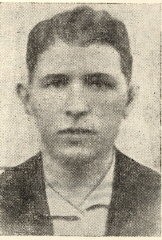
Alter Dvoretsky, head of the Zhetel Judenrat (Jewish council) and leader of the Zhetel underground.
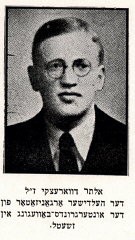
Benjamin Miedzyrzecki (Benjamin Meed), a member of the Jewish underground living in hiding on false papers, poses in Ogrod Saski (Saski Gardens) on the Aryan side of Warsaw. Poland, 1943.
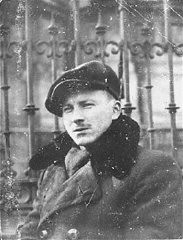
While living in hiding on the Aryan side of Warsaw, Benjamin Miedzyrzecki (Ben Meed) returns to the site of the Warsaw ghetto, where he poses among the ruins. Warsaw, Poland, 1944.

False identification card photo of Benjamin Miedzyrzecki (Benjamin Meed) as a member of the Warsaw ghetto underground. Warsaw, Poland, 1943.
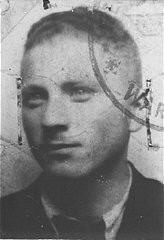
Vladka and Benjamin Meed (center) with President Jimmy Carter at a White House Rose Garden ceremony marking the official presentation of the report of the US Holocaust Commission to the president by commission chairman Elie Wiesel. Washington, DC, September 27, 1979.
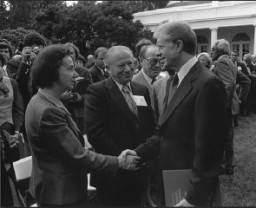
Members of the United States Holocaust Memorial Council pose with two milkcans containing a Scroll of Remembrance signed by Holocaust survivors at a symbolic groundbreaking ceremony for the United States Holocaust Memorial Museum. Benjamin Meed is second from the left. Washington, DC, April 30, 1984. During groundbreaking ceremonies in April 1985, the containers were buried on the site of the Museum.
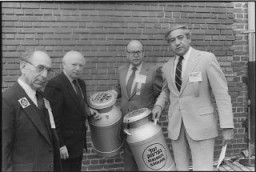
Benjamin Meed (right) and Harvey Meyerhoff stand next to the cornerstone for the United States Holocaust Memorial Museum. In October 1988, President Ronald Reagan spoke at a special ceremony held when the cornerstone of the Museum was laid, with construction beginning in July 1989 and ending in April 1993. Washington, DC, 1988.
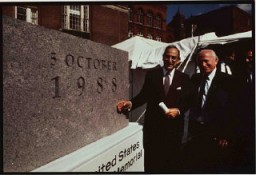
Members of the United States Holocaust Memorial Council pose with President George Bush (third from right) on the occasion of the 1989 Days of Remembrance. Benjamin Meed is fourth from the right. Washington, DC, 1989. Learn more about Days of Remembrance.
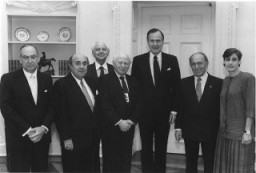
Laura Bush, George Bush, and Benjamin Meed during the Days of Remembrance ceremony in 2001, the theme of which was "Remembering the past for the sake of the future." Days of Remembrance was established by the United States Congress as the United States' annual commemoration of the victims of the Holocaust, just as the United States Holocaust Memorial Museum was established as a permanent living memorial to those victims.
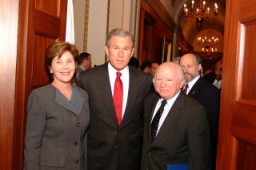
Benjamin Meed (left) with Fred S. Zeidman, Colin L. Powell, Elie Wiesel, and Ruth B. Mandel at the 2003 Days of Remembrance ceremony in the US Capitol Rotunda.
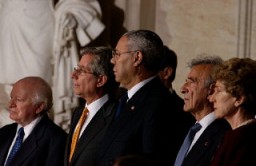
Benjamin Meed joins children in burying a time capsule during the Tribute to Holocaust Survivors: Reunion of a Special Family, one of the Museum's tenth anniversary events. Washington, DC, November 2003.
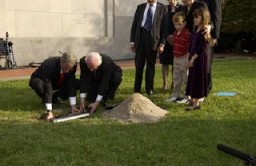
Benjamin Meed, Elie Wiesel (second and third from left), and two children bury a time capsule during the Tribute to Holocaust Survivors: Reunion of a Special Family, one of the Museum's tenth anniversary events. Washington, DC, November 2003.
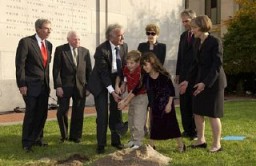
Portrait of Benjamin Meed, leading advocate for Jewish Holocaust survivors and a founder of the United States Holocaust Memorial Museum.
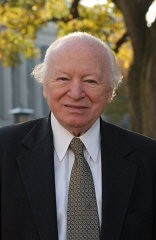
View of buildings in the Natzweiler concentration camp. Beginning in the summer of 1943, the Germans detained many "Night and Fog" prisoners in Natzweiler-Struthof. This photograph was taken following the liberation of the camp. Natzweiler-Struthof, France, 1945.
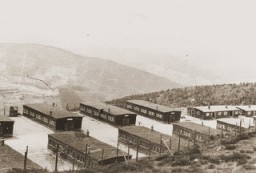
View of the Natzweiler concentration camp. Photograph taken in 1945.
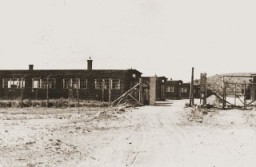
Entrance to a factory built into the side of a hill at the Natzweiler concentration camp. 1945.
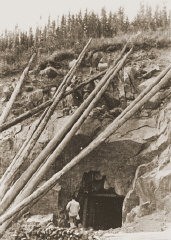
An American Jewish Joint Distribution Committee (JDC) clothing supply center for refugees. Vilna, Lithuania, 1940.
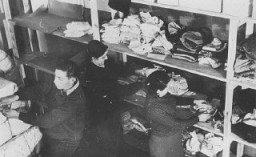
Displaced persons stand on a train platform in the weeks after the end of World War II in Europe. Kolleda, Germany, June 1945.
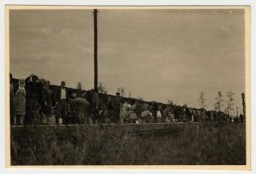
Displaced persons wait next to their suitcases and bundles, place uncertain, ca. 1947.

International Red Cross Poster showing photographs of children in a refugee camp in Chad. Titled "Help us find our family." Chad, 2005.
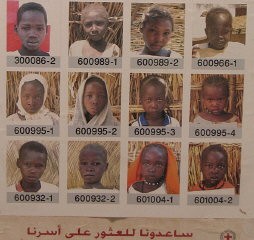
Refugees in a camp in eastern Chad for refugees from the Darfur region of neighboring Sudan. Jerry Fowler, Staff Director of the Museum's Committee on Conscience, visited in May 2004 to hear firsthand the refugees' accounts of the genocidal violence they faced and of being driven into the desert.
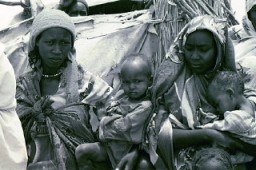
Refugees line up in a camp in eastern Chad for refugees from the Darfur region of neighboring Sudan. Jerry Fowler, Staff Director of the Museum's Committee on Conscience, visited in May 2004 to hear firsthand the refugees' accounts of the genocidal violence they faced and of being driven into the desert.
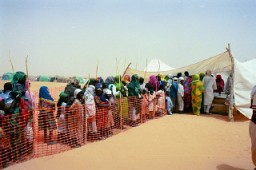
Relief supplies in a refugee camp in eastern Chad for refugees from the Darfur region of neighboring Sudan. Jerry Fowler, Staff Director of the Museum's Committee on Conscience, visited in May 2004 to hear firsthand the refugees' accounts of the genocidal violence they faced and of being driven into the desert.
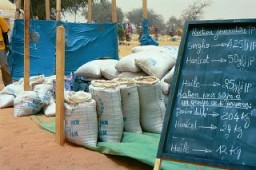
A camp for Darfurian refugees in Chad. Photograph taken in 2005. In July 2004 the United States Holocaust Memorial Museum declared a Genocide Emergency for the Darfur region of Sudan.
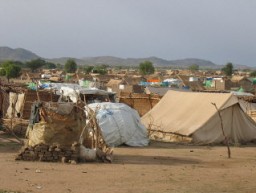
Refugees displaced by the violence in Syria walk to a transit center in Jordan where they will be transported to the Zaatari refugee camp. February 2014.
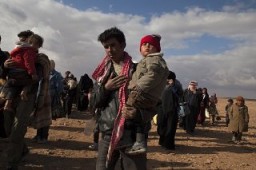
Refugees displaced by the violence in Syria wait at a transit center in Jordan for trucks that will take them to the Zaatari refugee camp. February 2014.
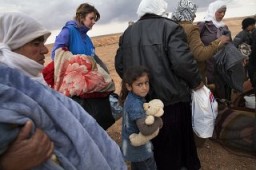
Refugees displaced by violence in Syria board trucks at a transit center in Jordan that will take them to the Zaatari refugee camp in February 2014.
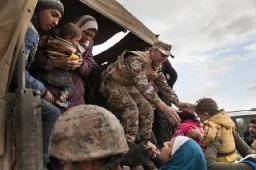
An elderly Yazidi woman tends to young children beside a half-constructed building in an internally displaced persons (IDP) camp where they live in Duhok, Iraqi Kurdistan. September 7, 2015.
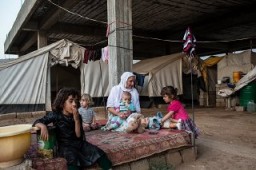
A mother checks on her sick daughter inside the container where they live in an internally displaced persons (IDP) camp near Erbil, Iraqi Kurdistan. September 1, 2015.
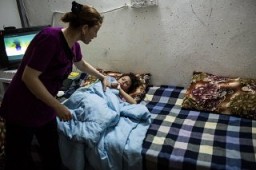
A Sunni man from Mosul, Iraq, prays as the sun sets over an internally displaced persons (IDP) camp near Erbil, Iraqi Kurdistan. September 2, 2015.
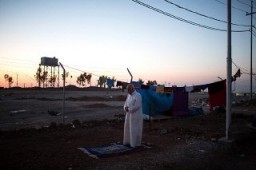
Displaced Iraqis wait for food distribution at an internally displaced persons (IDP) camp on the outskirts of Erbil, Iraqi Kurdistan. September 2, 2015.
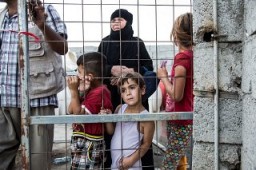
A Syrian girl looks over the Domiz refugee camp outside Duhok, Iraqi Kurdistan. Sepember 5, 2015.
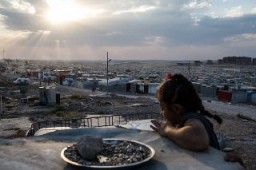
Refugee boys from Syria play on old tents in the Domiz refugee camp outside Duhok, Iraqi Kurdistan. September 5, 2015.
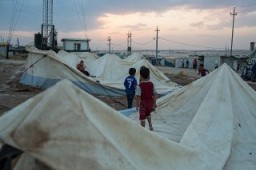
Staff from the Hadamar euthanasia center, including senior physician Adolf Wahlmann (front, left), during their trial. Wiesbaden, Germany, October 8-15, 1945.
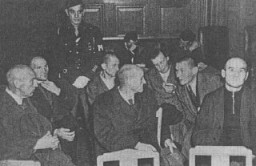
Jehuda “Lolek” Lubinski (seen here in the 4th row, 2nd from left). During his time in the Lodz ghetto, Lolek kept a diary in which he described events of the day as well as his hopes and despairs.
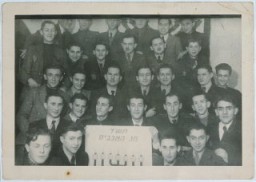
Group portrait of teenage boys in the Lodz ghetto. Dawid Sierakowiak is in the 3rd row, 4th from right. Dawid kept a diary from before the war where he meticulously noted not only events but also his own feelings, moods, and opinions. Dawid was an avid reader and an excellent observer.
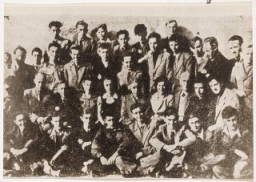
Panzer tanks of Erwin Rommel's Africa Corps during an advance against British armed forces. Libya, 1941-1942.
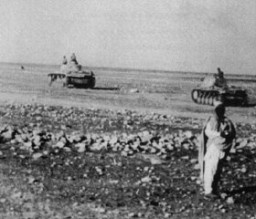
Lieutenant General (later Field Marshal) Erwin Rommel commanded German forces during the campaign in North Africa. Libya, 1941.
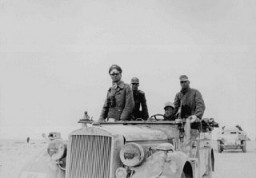
General Bernard L. Montgomery, commander of British forces in Egypt, watches British tanks move toward German lines during the military campaign in North Africa. November 1942.

Generals Dwight D. Eisenhower and George S. Patton discuss Allied military operations in North Africa. Djebel Kouif, Algeria, March 16, 1943.
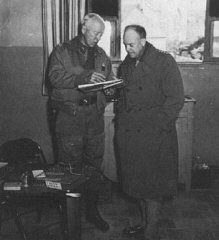
Allied troops board amphibious assault boats off the Algerian coast during Operation Torch. North Africa, November 1942.
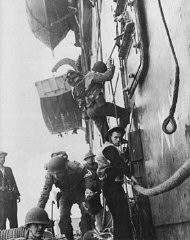
Allied troops march in Tunis following Allied success against Axis forces in the African Campaign. Tunis, Tunisia, May 20, 1943.
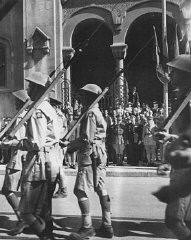
Stephen S. Wise, later to become president of the World Jewish Congress, speaks at an anti-Nazi rally at Madison Square Garden. New York, United States, March 27, 1933.
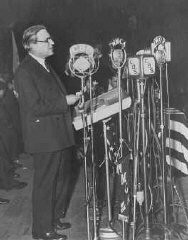
Nazi official Julius Streicher, founder of the antisemitic newspaper Der Stuermer (The Attacker) and organizer of the anti-Jewish boycott. Germany, date uncertain.
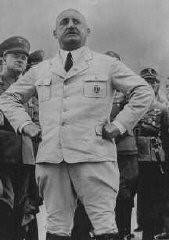
Nazi district leader of Franconia Julius Streicher (right), propaganda minister Joseph Goebbels (second from right), and other Nazi officials attend the opening of the exhibition Der ewige Jude (The Eternal Jew). Munich, Germany, November 8, 1937.
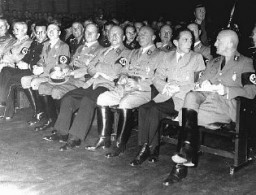
A German couple reads an outdoor display of the antisemitic newspaper Der Stürmer (The Attacker). Germany, 1935.
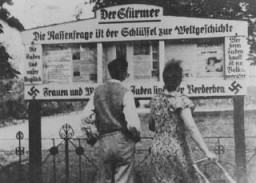
Page of Der Stürmer (The Attacker), a viciously anti-Jewish newspaper published by Julius Streicher. The illustration is an antisemitic photomontage, Germany, 1939. This image was presented as evidence at the Nuremberg trials.
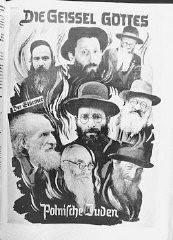
We would like to thank Crown Family Philanthropies, Abe and Ida Cooper Foundation, the Claims Conference, EVZ, and BMF for supporting the ongoing work to create content and resources for the Holocaust Encyclopedia. View the list of donor acknowledgement.